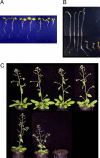Organization of cellulose synthase complexes involved in primary cell wall synthesis in Arabidopsis thaliana
- PMID: 17878303
- PMCID: PMC2000492
- DOI: 10.1073/pnas.0706569104
Organization of cellulose synthase complexes involved in primary cell wall synthesis in Arabidopsis thaliana
Abstract
In all land plants, cellulose is synthesized from hexameric plasma membrane complexes. Indirect evidence suggests that in vascular plants the complexes involved in primary wall synthesis contain three distinct cellulose synthase catalytic subunits (CESAs). In this study, we show that CESA3 and CESA6 fused to GFP are expressed in the same cells and at the same time in the hypocotyl of etiolated seedlings and migrate with comparable velocities along linear trajectories at the cell surface. We also show that CESA3 and CESA6 can be coimmunoprecipitated from detergent-solubilized extracts, their protein levels decrease in mutants for either CESA3, CESA6, or CESA1 and CESA3, CESA6 and also CESA1 can physically interact in vivo as shown by bimolecular fluorescence complementation. We also demonstrate that CESA6-related CESA5 and CESA2 are partially, but not completely, redundant with CESA6 and most likely compete with CESA6 for the same position in the cellulose synthesis complex. Using promoter-beta-glucuronidase fusions we show that CESA5, CESA6, and CESA2 have distinct overlapping expression patterns in hypocotyl and root corresponding to different stages of cellular development. Together, these data provide evidence for the existence of binding sites for three distinct CESA subunits in primary wall cellulose synthase complexes, with two positions being invariably occupied by CESA1 and CESA3, whereas at least three isoforms compete for the third position. Participation of the latter three isoforms might fine-tune the CESA complexes for the deposition of microfibrils at distinct cellular growth stages.
Conflict of interest statement
The authors declare no conflict of interest.
Figures




Similar articles
-
Genetic evidence for three unique components in primary cell-wall cellulose synthase complexes in Arabidopsis.Proc Natl Acad Sci U S A. 2007 Sep 25;104(39):15566-71. doi: 10.1073/pnas.0706592104. Epub 2007 Sep 18. Proc Natl Acad Sci U S A. 2007. PMID: 17878302 Free PMC article.
-
Phytochrome regulation of cellulose synthesis in Arabidopsis.Curr Biol. 2011 Nov 8;21(21):1822-7. doi: 10.1016/j.cub.2011.09.026. Epub 2011 Oct 27. Curr Biol. 2011. PMID: 22036185
-
Features of the primary wall CESA complex in wild type and cellulose-deficient mutants of Arabidopsis thaliana.J Exp Bot. 2008;59(10):2627-37. doi: 10.1093/jxb/ern125. Epub 2008 May 20. J Exp Bot. 2008. PMID: 18495638 Free PMC article.
-
Cellulose synthesis: a complex complex.Curr Opin Plant Biol. 2008 Jun;11(3):252-7. doi: 10.1016/j.pbi.2008.03.007. Epub 2008 May 14. Curr Opin Plant Biol. 2008. PMID: 18485800 Review.
-
Cellulose biosynthesis in plants: from genes to rosettes.Plant Cell Physiol. 2002 Dec;43(12):1407-20. doi: 10.1093/pcp/pcf164. Plant Cell Physiol. 2002. PMID: 12514238 Review.
Cited by
-
Fission yeast Bgs1 glucan synthase participates in the control of growth polarity and membrane traffic.iScience. 2024 Jul 8;27(8):110477. doi: 10.1016/j.isci.2024.110477. eCollection 2024 Aug 16. iScience. 2024. PMID: 39156640 Free PMC article.
-
Alleles Causing Resistance to Isoxaben and Flupoxam Highlight the Significance of Transmembrane Domains for CESA Protein Function.Front Plant Sci. 2018 Aug 24;9:1152. doi: 10.3389/fpls.2018.01152. eCollection 2018. Front Plant Sci. 2018. PMID: 30197649 Free PMC article.
-
Cotton CSLD3 restores cell elongation and cell wall integrity mainly by enhancing primary cellulose production in the Arabidopsis cesa6 mutant.Plant Mol Biol. 2019 Nov;101(4-5):389-401. doi: 10.1007/s11103-019-00910-1. Epub 2019 Aug 20. Plant Mol Biol. 2019. PMID: 31432304
-
The Photoperiodic Flowering Time Regulator FKF1 Negatively Regulates Cellulose Biosynthesis.Plant Physiol. 2019 Aug;180(4):2240-2253. doi: 10.1104/pp.19.00013. Epub 2019 Jun 20. Plant Physiol. 2019. PMID: 31221729 Free PMC article.
-
Cellulose synthase interacting protein: a new factor in cellulose synthesis.Plant Signal Behav. 2010 Dec;5(12):1571-4. doi: 10.4161/psb.5.12.13621. Epub 2010 Dec 1. Plant Signal Behav. 2010. PMID: 21150290 Free PMC article. Review.
References
Publication types
MeSH terms
Substances
LinkOut - more resources
Full Text Sources
Other Literature Sources
Molecular Biology Databases

